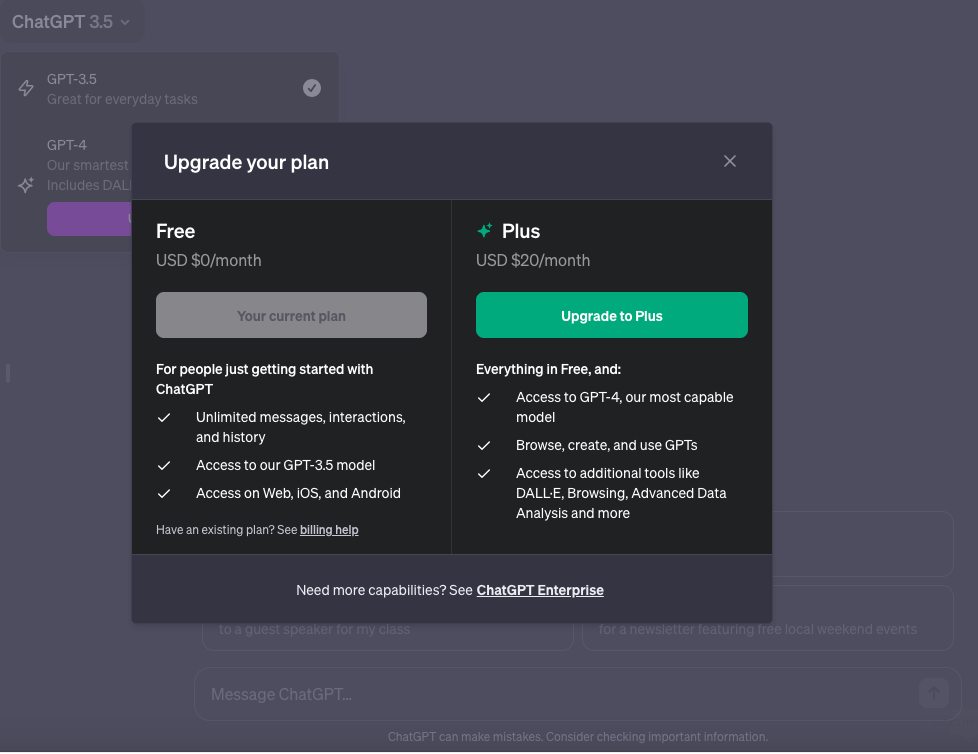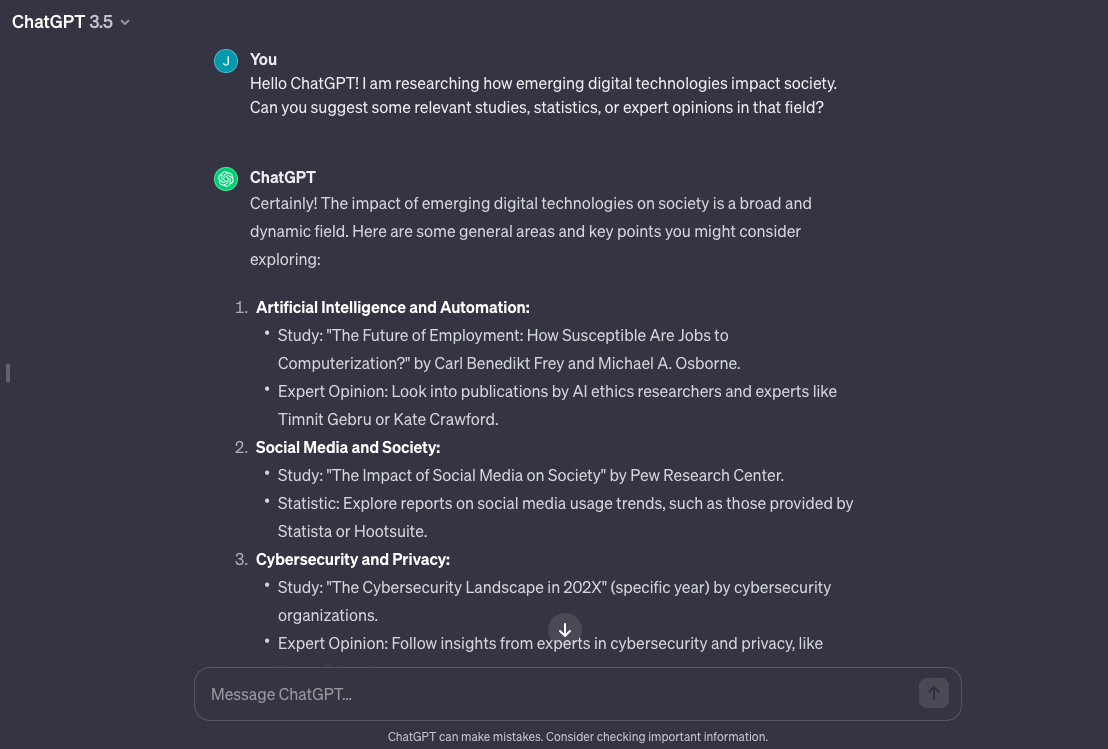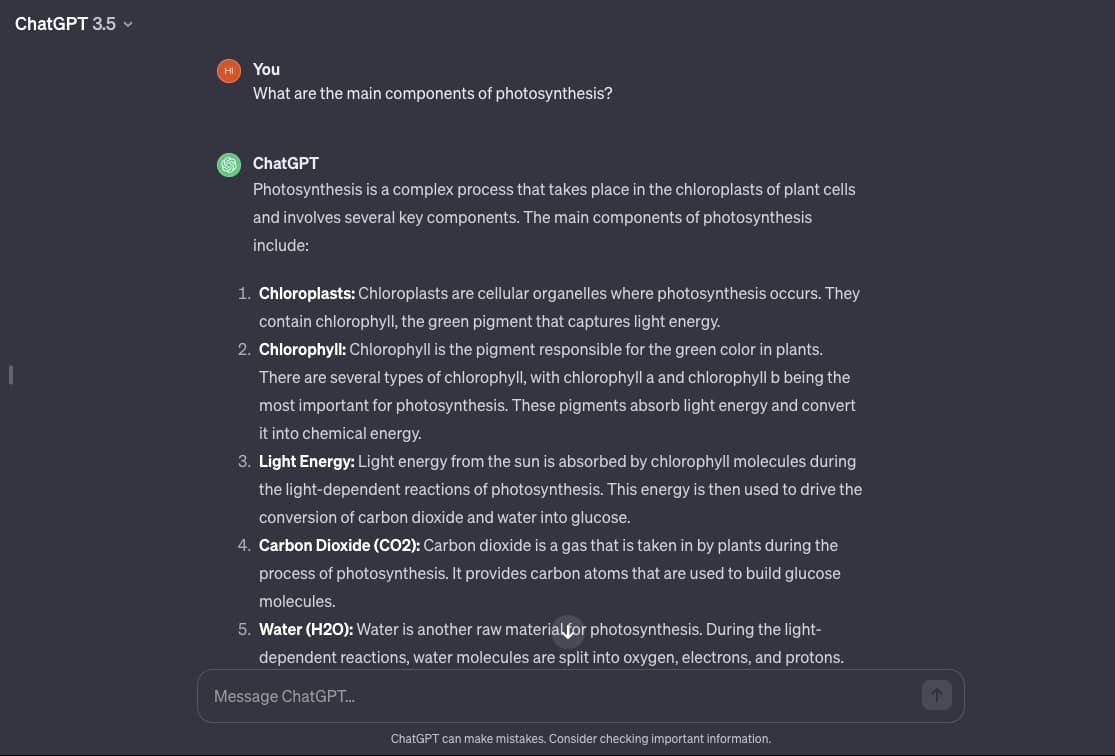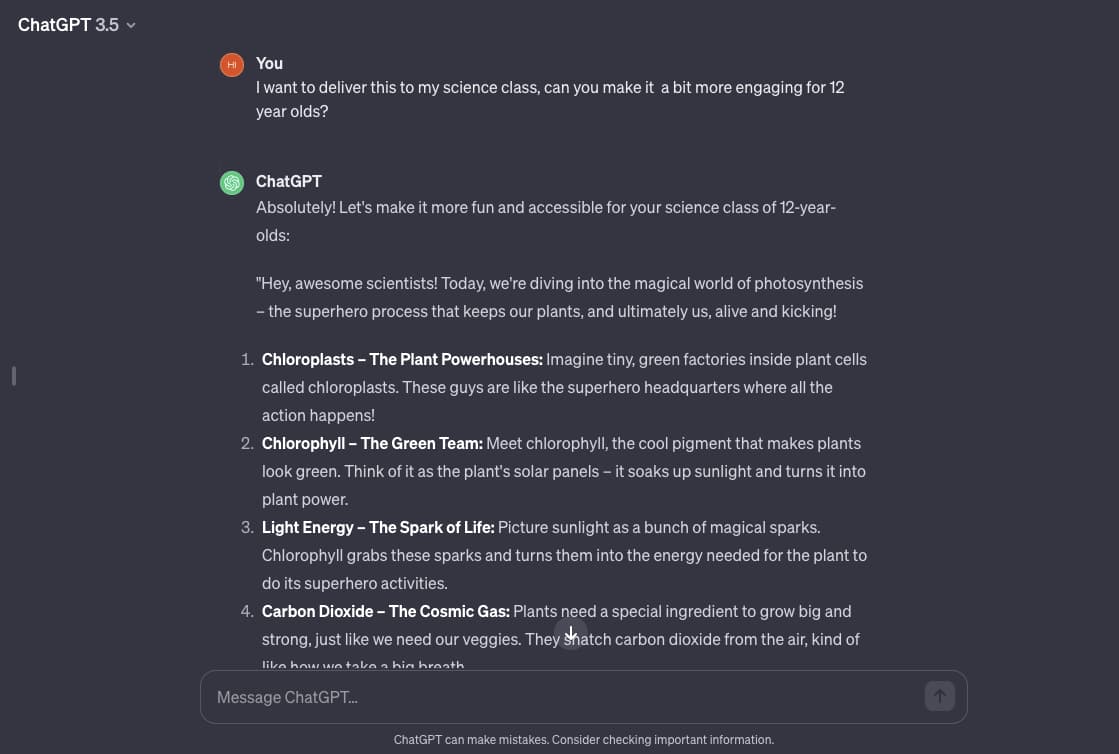It’s been a little over a year since Open AI launched ChatGPT, with no lack of fanfare. As of 2024, ChatGPT has 180 million monthly active users, and more than 92% of Fortune 500 companies use it.
But we are still at the beginning of the artificial intelligence (AI) revolution, so there’s no better time to start getting familiar with how the technology works.
When there’s a new tech in town, leveling-up your skills sometimes requires wrangling with algorithms or complex user interfaces. Learning how to use ChatGPT is more about the art of communication.
In this comprehensive guide, we’ll show you how to use ChatGPT step-by-step. Whether you’re creating a digital marketing strategy, streamlining tedious activities in your daily life, or just want to have fun with it, we’ve got you covered.
We’ll cover the following topics:
- How to use ChatGPT: Step-by-step guide
- Step 1: Sign up for ChatGPT
- Step 2: Familiarize yourself ChatGPT’s features and settings
- Step 3: Start a conversation
- Step 4: Generate content
- Step 5: Refine output
- Step 6: Be mindful of token limits
- Step 7: Fact and sense-checking
- Step 8: Tailor ChatGPT to your use case
- ChatGPT for images
- Useful tips
- Closing thoughts
Ready to learn how to use ChatGPT to the best of its ability? Let’s dive in.
How to use ChatGPT: Step-by-step guide
ChatGPT’s brilliance is that it’s easier to use than many tech of years past—think command line interfaces or trying to program the VCR. That said, ChatGPT is a more complex beast than it lets on.
While the interface is pretty straightforward to use (it’s called conversational AI for a reason!), behind the scenes, tech experts are regularly tweaking the ChatGPT model, subtly changing how it can be used. To get the best out of ChatGPT requires a few nuanced skills. In this step-by-step guide, we’ll cover all of these.
Starting from scratch? We recommend starting with this guide: What is ChatGPT?
Otherwise, let’s get started.
Step 1: Sign up for ChatGPT
Navigate to the official OpenAI website and look for the ChatGPT platform (or just pop it into Google). If you’re already an OpenAI user, sign in. If not, you’ll need to follow the prompts to create a new account. You can sign up using your email address or using a single sign-on with your Google, Microsoft, or Apple account.

Once you’ve signed in, you’ll be sent to the free version of ChatGPT by default. The free version works well enough.
The paid version of ChatGPT costs $20/month. It uses a more advanced model and comes with additional features:
- faster response times
- internet access (allowing the model to verify its output with real-time sources),
- ChatGPT for data analytics
- image-enhanced prompts
- access to the latest version of Open AI’s impressive image generation tool, DALL·E.

You can see the latest features that are available by clicking on the dropdown menu at the top of the welcome screen. But more on this in a later section!
Should I use the ChatGPT mobile app?
While there is a ChatGPT app, which is great, we’d argue that for most use cases, the desktop browser probably offers the best experience. It’s also more likely that you’ll be at your desktop or laptop when using it to its maximum capability.
Step 2: Familiarize yourself with ChatGPT’s features and settings
Take a moment to acquaint yourself with the interface. The box at the bottom is the input field for your queries. The area just above this is where the AI’s responses will appear.
If you’re on a desktop browser, each conversation that you have with ChatGPT is automatically saved and appears in the left-hand panel. The tool will also automatically name these chats based on the topic of your discussion.
ChatGPT will save all your past conversations in the chat history bar when you’re logged in. This makes it easier for you to navigate, while also using the data to improve its language model.
Tip: Many people don’t realize that you can also rename, share, archive, or delete individual chats. Simply click on the chat you want to edit and it will provide you with the options.
Don’t forget to check out the Settings! You can access these by clicking on your name at the bottom of the left-hand panel (if you’re using the desktop browser).
From here you can delete your past chats, manage your archive, and create custom instructions.
If you’re like us, you might want to switch to dark mode (it’s a bit easier on the eyes if you sit in front of a computer a lot!)

Step 3: Start a conversation
To start interacting with ChatGPT, simply click on the input field and type your question (also known as a query, or prompt). For the best output, try to ensure your input is clear and concise, providing the AI with all the necessary information it needs.
If you’re new to using ChatGPT, you might want to start a conversation by asking it a few questions first. For example: “What things can I use ChatGPT for?”

Didn’t realize it could do translations? Ask it for more information.
From here, the possibilities are endless.
For example, maybe you want help with creative writing, coming up with new story ideas, or getting the history of a specific topic. Play with your prompts to get the most accurate and helpful responses for your specific use case.
Let’s say you’re researching how emerging digital technologies impact society. You can inquire about relevant studies, statistics, or expert opinions in that field to get you started:

Step 4: Generate content
While ChatGPT has many use cases, they all rely on the tool’s ability to understand human language and generate context-appropriate content.
Let’s say you work for a small toy company and want to hire a marketing expert to promote your new line of computer games. You could ask ChatGPT to write you a job description.

Let’s be honest—it reads a little generically. If you’re not happy with the output, ask ChatGPT to regenerate its response by clicking on the refresh button just beneath the text input box. This will give you an alternative output to choose from.
If you want, can also provide feedback on ChatGPT’s outputs. This is not strictly necessary, but any feedback you provide is used to refine the tool. If you’re not 100% happy with its output, which let’s face it, you might not be on the first go, how can you improve it?
Let’s take a look.
Step 5: Refine output
With a little tweaking, you can transform ChatGPT’s drier and more generic-sounding responses into something more lively, engaging, and relevant.
Let’s return to our previous example of the job description for a small toy company. Perhaps you found the original output too generic or long-winded. In this case, you could ask ChatGPT to try again, this time using less “fluff” or sticking to the facts.

While this output still isn’t perfect, it’s an improvement, focusing much more on the responsibilities that come with the role.
When you find that ChatGPT’s output is too generic, keep in mind that the issue might be that you didn’t provide it with enough information. And if you give it too much information, the tool might focus on the wrong areas.
Essentially, you need to keep refining ChatGPT’s output until it produces something close to what you’re looking for. You can then make the final tweaks yourself. This allows you to guide the AI, shaping its style and tone to your preferences.
To illustrate, let’s imagine the following scenario.
You’re a science teacher and want to summarize the key aspects of photosynthesis. You might start with a straightforward prompt:
“What are the main components of photosynthesis?”
In response, ChatGPT will generate an informative yet (probably) quite dry explanation of the process.

This might be factually accurate, but it will bore the pants off your students. Why not ask ChatGPT to make the content a bit more engaging? You can ask it to do just that.

And there we have it! Although this output isn’t perfect—it could arguably use clearer facts—it’s an improvement on the first version.
You could go even further, with prompts like “pitch this for a slightly older age group”, or, “expand on each section to offer more factual detail.”
Whatever you’re using ChatGPT for, the main thing is to look beyond the first output it provides.
Consider the style and tone, metaphors, or creative elements you’d like to incorporate and instruct the AI to incorporate these. And always think about your audience.
Whether you’re discussing scientific processes, historical events, or any other topic, you can add a personalized touch to the AI’s responses, tailoring its output to meet your needs.
Step 6: Be mindful of token limits
Some behind-the-scenes insight that’s important to note: ChatGPT works by breaking down prompts and responses into short chunks known as tokens. A token might be one word or even just a single character.
Why is this important? Well, ChatGPT has a limit on how many of these tokens it can handle in one go. It is currently set at 4,096 tokens, and both the input prompt and generated output use up tokens.
As you chat with the tool, keep an eye on the length of your conversation. If it gets too long and surpasses the token limit, you might need to trim it down or simplify your prompts to fit within token limit constraints.
If not, ChatGPT will still work but it might result in less useful responses, and it is likely to forget the beginning of your conversation. This can be a pain, but we’ll look at tips for how to get around this in a later section.
Step 7: Fact and sense-checking
As you engage with ChatGPT—especially if you’re dealing with factual information rather than, let’s say, creative outputs—always take time to manually fact- and sense-check its output. ChatGPT is powerful, but isn’t always good at acknowledging when it lacks information. It has an unfortunate tendency to “hallucinate” (even if you specifically ask it not to).
You can learn more about AI hallucinations, catastrophic forgetting, and other horrors in our guide to interesting AI terms.
Take a look at this example, where we ask ChatGPT about the four survivors of the spaceship Nostromo in the 1979 cult movie, Alien:

ChatGPT provides a very clear response, listing four survivors. But if you’ve actually seen the movie, you’ll know that there is only one survivor (two if you count the cat, but ChatGPT didn’t even get that right!).
While this example relies on a misleading input, hallucinations can pop up unexpectedly at any time, and they’re not always easy to spot.
Math is another area where the tool often falls down. As such, always verify the information ChatGPT provides before using it in any official capacity. We’d say it’s best to use ChatGPT as a productivity tool that can help you talk about topics you’re already knowledgeable about, saving you time with drafting content but also allowing you to quickly spot any obvious errors.
The paid version of ChatGPT, which can browse the internet, references the facts it provides with live links to sources. That’s not to say that the source material is always accurate, either. But it’s better than nothing!
Step 8: Tailor ChatGPT to your use case
Now that we’ve covered the general steps for how to use ChatGPT, let’s briefly explore how you can tailor the tool to specific use cases.
How to use ChatGPT for digital marketing
While it won’t run your entire operation (at least not yet!) here’s how to use ChatGPT to streamline some of your digital marketing tasks:
- Generate ideas: Simply input your area of marketing, such as the product or service you’re promoting, along with a short customer profile, and ChatGPT will offer fresh ideas for blog posts, social media content, or email marketing campaigns.
- Copywriting assistance: Once you’ve fleshed out some ideas, use ChatGPT to draft the initial written copy for ads or promotions. Tweak its tone and style until you have a draft you use or share with your team.
- Market research: Ask it to produce a table of your key competitors, including their unique offerings. Be aware that ChatGPT Plus is best for this, as it’s capable of browsing the internet (currently, the free version has a cut-off point, or “knowledge horizon,” which means its information is about a year out of date).
Not sure where to start? Check out our guide to the 18 best ChatGPT prompts for digital marketing.
If you’re looking to upgrade your digital marketing skills overall, check out CareerFoundry’s Digital Marketing Program, which now incorporates AI as an integral part of the curriculum.
ChatGPT for coding/programming
ChatGPT is an excellent tool for programming-related tasks. And you don’t have to be an expert coder to use it. On the contrary, you can use ChatGPT for:
- Refining code: Improve existing code by asking ChatGPT for suggestions or to clean up your syntax. If you tell it what you’re trying to achieve, it will also provide code snippets so you don’t have to start from scratch.
- Debugging: Describe the coding problems you’re facing and ChatGPT will provide potential solutions and workarounds.
- Algorithmic advice: Ask for advice on which algorithm to select for a specific programming task, and ChatGPT will usually offer an appropriate solution.
Note: ChatGPT Plus (the paid version) is significantly better at coding tasks and even has a dedicated “advanced analytics” feature that can write Python code. While the free version is still light years ahead of going it alone, ChatGPT’s free outputs usually require more tweaking.
For a list of potential prompts, check out our guide to ChatGPT coding prompts.
ChatGPT for academic research
If you’re studying for a degree or conducting research, you can use ChatGPT for academic purposes (though we strongly recommend not using it to write papers…):
- Summarizing content: If you input complex academic articles or concepts, ChatGPT will offer concise summaries. While this isn’t a replacement for reading the original, it’s excellent for narrowing down areas you want to focus on.
- Literature reviews: Ask ChatGPT for insights into existing literature related to your research area. Providing specific keywords will focus on the response.
- Drafting executive summaries: As any good researcher knows, you should write the executive summary last! Now you don’t even have to do that—simply input your paper and ask ChatGPT to write the draft summary for you (but check it carefully!)
ChatGPT for legal analysis
A British judge recently said that ChatGPT was “jolly useful”, demonstrating that it is used even in legal matters. Okay, so you’re probably not a judge, but you can still use ChatGPT for:
- Checking your rights: Inquire about legal rights, obligations, or general legal information that is relevant to your situation.
- Drafting official documents or letters: Most legal documents/letters need to tick certain statutory boxes, something which ChatGPT excels at.
- Perfecting legal language: ChatGPT can help refine the legal language in your documents to ensure they sound professional and adhere to legal conventions.
ChatGPT for creative writing
Last but not least, you can use ChatGPT for fun, creative writing projects, too!
- Character development: Describe the traits and background of characters to receive creative suggestions for how to develop them.
- Plot outlines: You can also ask ChatGPT for ideas about plot twists, settings, or overall story arcs. They might not all be perfect, but they’ll certainly spark some ideas.
- Drafting poems: Ask ChatGPT to write you a cheeky limerick and see what it comes up with! We’ll admit, this is more for fun… it hasn’t quite mastered humor yet.

2. How to use ChatGPT for images
While ChatGPT is best known for text generation, did you know that OpenAI is also the company that created one of the first image-generation AI tools, DALL·E?
If you’re using ChatGPT Plus, the good news is that you can smoothly combine visual elements into your written prompts. For example, you can take a picture of a flower and then ask ChatGPT to identify it for you.
Here’s how to use ChatGPT’s image-enhanced prompt feature:
- First, make sure that ChatGPT’s model selector is set to GPT-4 (the version that allows for image inputs)
- Next, click the + icon in the prompt area to add images. You can upload an image file, or if you’re using a mobile device, simply take a picture (Note that ChatGPT currently only accepts JPEGs, PNGs, and non-animated GIFs)
- Add prompt text to provide context or to ask a question about the image.
How to use ChatGPT to generate images
In addition to enhancing your text prompts, ChatGPT Plus also integrates the latest and most sophisticated version of DALL·E, OpenAI’s text-to-image generator, which can create images directly from your text prompts. It is also miles ahead of current free text-to-image tools.
Here’s how to do it:
- Go to the ChatGPT home screen and select GPT-4
- Access the DALL·E feature
- Input your text prompt and simply ChatGPT transform your idea into sophisticated images. You can then tweak your input to change the image if you need to, and try again.
Let’s say you want to see an image of cats playing poker with a giraffe on a beach, in the style of an oil painting (let’s face it, why wouldn’t you want to see that?)
Simply type your description into the tool, and DALL·E will produce four options for you to choose from.

As you can see, these are pretty well-polished. The version of DALL·E that comes with ChatGPT Plus is much more advanced than the output from the free version, so if you’re using it primarily for image generation, it might be worth paying up.
3. Useful tips
Now we’ve covered everything you need to get started using ChatGPT, here are a few additional tips for getting the best out of the tool.
Ask ChatGPT to ask you questions
Most of the time, people start engaging with ChatGPT by asking it questions. Why not flip this on its head?
After you’ve introduced your topic of interest, encourage ChatGPT to ask you questions about it. This will encourage better-tailored responses and can also help spark new ideas. For example, perhaps you want to create a marketing strategy for your business. Tell ChatGPT to ask you some questions about it so that it can help you produce one.

Know when to create a new chat
As your conversation progresses, you’ll find yourself fine-tuning your prompts to achieve the desired output. For instance, if you’re seeking a summary on a specific topic, you might have to refine your initial prompt to guide it toward your preferred style.
Once you’re relatively satisfied with the direction of the output, consider copying and pasting the improved version into a new chat before crafting your next prompt. This will ensure the conversation starts from the most relevant point, avoiding the chances of ChatGPT using outdated inputs. This approach is one way of maintaining focus in the dialogue and circumventing issues related to token limits, as described in an earlier section.
Use the custom instructions tab
Under Settings, you will find the lesser-known custom instructions tab. This is a valuable feature that allows you to provide specific guidance to ChatGPT on how you want it to generate output, saving you from having to repeat yourself every time.

We’ve had fun with it here, but you can also tell it about your job (for example, “I work in product design”) and the features you require of all outputs (for example, “Please provide all outputs in the form of bulleted lists”). You get the idea. Experiment with it!
Remember ChatGPT’s limitations
Talking with ChatGPT sometimes feels like having a genuine back-and-forth conversation with a sentient being. It might sound obvious, but it’s good to keep in mind that this is just an illusion. In reality, ChatGPT generates outputs aligned with the patterns most present within its training data. While it has learned from many sources, its responses are influenced by the prevalence of certain language patterns and phrases within those data.
This means the model will produce responses more commonly reproduced in the context of the data it has been trained on. While this is great for generating contextually relevant output, it also means that it rarely produces anything unique, resulting in responses that are typically a bit generic.
To make your content stand out, always tailor it to your audience’s needs based on what you know about them. ChatGPT is a fantastic tool for getting started with content generation, summarization, or other projects, but it’s not yet capable of producing highly original material. And honestly, why would we want it to be? Giving content our personal stamp is the fun part!
4. Closing thoughts
There we have it—your comprehensive guide on how to use ChatGPT! In this post, we’ve delved into both the basics of ChatGPT and explored ways of tailoring it to specific use cases. As we’ve learned, ChatGPT is an incredibly diverse tool, but it is also a more complex beast than it might at first seem. And if the features available in the paid version of ChatGPT are anything to go by, its use cases will continue to grow more complex over time. And that means that getting the basics down is important as a foundation.
As our data expert points out in this video, ChatGPT is not the final form of AI:
Despite the seemingly magical nature of the interactions you can have with ChatGPT, don’t forget that it is merely a highly sophisticated algorithm that operates by drawing upon learned patterns from vast datasets. If you want truly exceptional interactions, you need to input your own original content. Your input then becomes the catalyst that transforms the conversation from something typically quite generic to something that is uniquely yours.
Want to learn more about how to use ChatGPT for digital marketing? Check out this free, 5-day digital marketing course, which integrates AI as a core component of the curriculum.
Or check out our introductory guides to ChatGPT:
